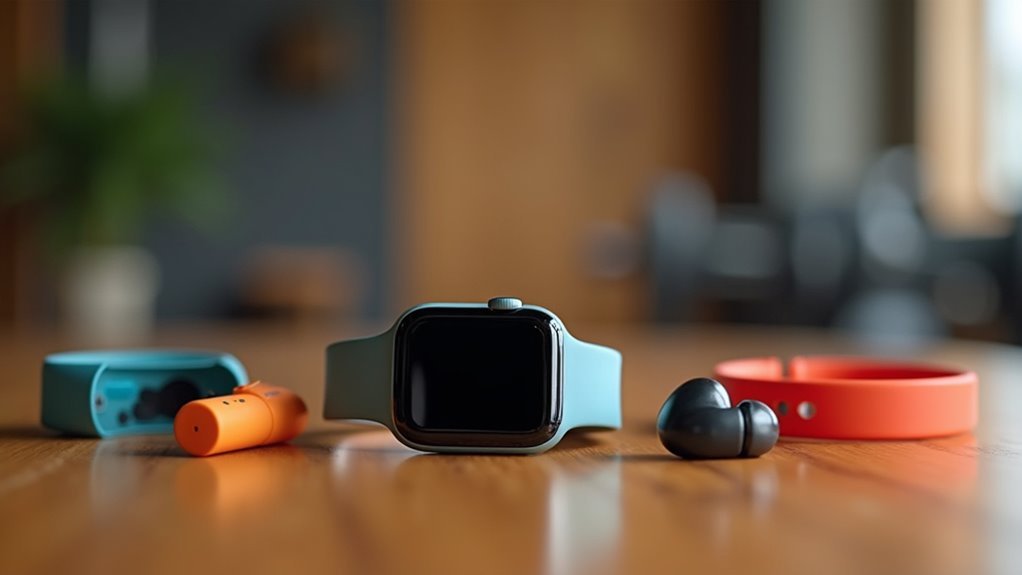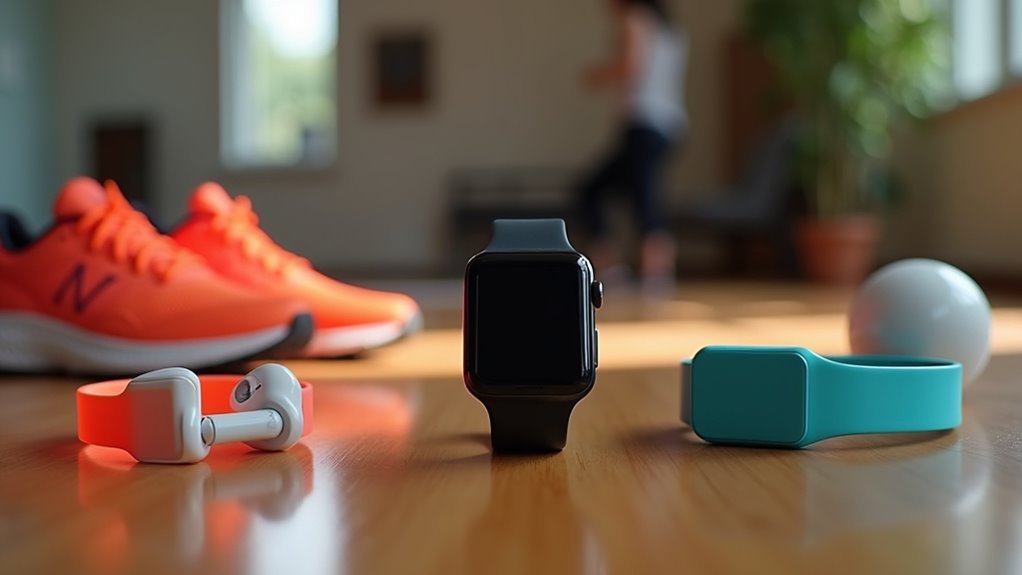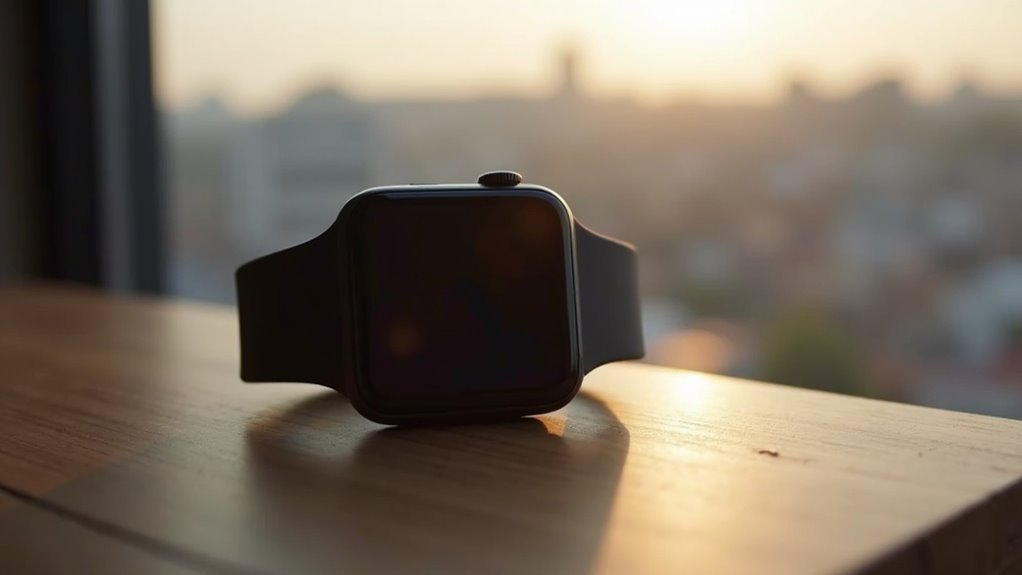You’ll find that Apple Watch models are virtually the only fitness wearables that offer true Siri integration, with compatibility spanning from the Series 3 through the latest Series 9 and Ultra models. The Apple Watch SE also provides full Siri functionality at a budget-friendly price point. While some third-party fitness apps can work with Siri through the Apple Watch, non-Apple wearables can’t access Siri’s voice control features due to ecosystem limitations. Explore below for extensive setup details and alternatives.
Apple Watch Series Models and Siri Compatibility

When considering fitness wearables with Siri integration, Apple Watch models offer varying levels of compatibility and functionality across their different generations.
The Series 3 introduced voice feedback through its built-in speaker and cellular independence, though software updates stopped at watchOS 8.8.1.
Series 3 marked a turning point with voice feedback and cellular capabilities, though its software support has since reached its limit.
Series 4-6 models enhanced Siri accuracy with improved microphone arrays and added health monitoring features like ECG functionality.
Series 7-8 provide smoother Siri operation with enhanced processing power and full watchOS 10 compatibility.
The newest Series 9 and Ultra models deliver advanced Siri functionalities with international roaming support and superior voice recognition. All Apple Watch models feature all-day battery life that supports continuous Siri usage throughout typical daily activities.
Apple Watch SE models maintain full Siri compatibility despite lacking advanced health sensors, offering budget-friendly options with complete voice command support.
Native Siri Integration Features in Apple Watches
Beyond basic compatibility, Apple Watch’s native Siri integration transforms how you interact with fitness data through extensive voice-enabled features.
You can track movement, standing, and exercise through simple voice commands like “How far have I walked today?” or “How are my Activity Rings?” This hands-free approach lets you check progress without manual input.
Siri helps manage personalized daily goals and can announce ring completions or remind you about unmet targets. You’ll receive voice reminders for stand goals and exercise milestones, with notifications syncing between your Apple Watch and iPhone.
Advanced workout support includes voice-launching specific exercises, pausing sessions, and accessing recent workout summaries. The Activity app configuration occurs during your Apple Watch setup, allowing you to begin voice-controlled fitness tracking immediately.
Siri also provides quick daily, weekly, or monthly activity trend analysis, though some features aren’t available in all regions.
Voice Command Capabilities for Fitness Tracking
You can control your fitness tracking through voice commands using Siri’s built-in features, though the experience varies greatly between Apple and non-Apple devices.
Most fitness wearables claiming Siri compatibility actually route your voice commands through a paired iPhone rather than processing them directly on the device itself.
When Siri isn’t available or doesn’t meet your needs, you’ll find several third-party voice assistants that offer alternative ways to manage your workouts and health data. Many fitness wearables support multiple languages for voice commands, making them accessible to users who prefer Spanish or French interfaces alongside the standard English options.
Siri Voice Control Features
Fitness wearables have transformed how you interact with health data during workouts, and Siri voice control stands at the forefront of this hands-free revolution. You can start, pause, and end workouts using simple voice commands, eliminating the need to fumble with buttons mid-exercise. Siri lets you query live metrics like heart rate, distance, and calories burned without breaking your stride.
Beyond fitness tracking, you’ll control music playbook, send messages, and make calls seamlessly during workouts. The comprehensive ecosystem includes advanced health features like ECG monitoring and cycle tracking that integrate smoothly with Siri voice commands.
The Apple Watch’s on-device Siri processing guarantees faster responses and enhanced privacy when accessing your health data. These voice features keep you focused on your exercise while maintaining full control over your device’s functionality through natural speech commands.
Third-Party Voice Assistant Alternatives
While Siri dominates Apple’s ecosystem, several compelling voice assistant alternatives offer extensive fitness tracking capabilities across different platforms and devices.
Samsung Galaxy Watch series supports multiple voice assistants including Bixby and Google Assistant, giving you broader voice command options. Google Pixel Watch integrates Google Assistant deeply for thorough fitness monitoring, while Garmin’s Venu 3 provides onboard voice assistant support with offline capabilities.
For privacy-conscious users, Picovoice offers on-device voice AI that processes data locally without cloud connectivity, protecting your personal information while extending battery life. The smart fitness market continues to expand rapidly with projected growth exceeding 10% annually, driven by consumers seeking integrated voice-controlled exercise solutions.
Amazon Alexa excels at health reminders and connects with third-party fitness apps like Fitbit and MyFitnessPal through specialized skills, though it lacks built-in tracking features.
Third-Party App Support With Siri on Apple Watch
You can expand your Apple Watch’s fitness capabilities by integrating popular third-party workout apps that support Siri voice commands.
These apps offer specialized features like guided runs, cycling metrics, or yoga sessions while still contributing to your Activity rings.
However, you’ll need to configure specific permissions and sync settings to guarantee Siri can properly control these external fitness applications. You’ll also need to grant Health app permissions to enable proper data integration between your third-party workout apps and your Apple Watch’s fitness tracking system.
Popular Fitness Apps
Since Apple Watch became the dominant smartwatch platform, numerous third-party fitness apps have embraced Siri integration to enhance your workout experience.
These popular fitness apps showcase Siri’s capabilities:
- Nike Run Club – Start runs with voice commands and receive proactive workout suggestions based on your running habits.
- SmartGym – Initiate workouts and modify exercises directly from your Apple Watch using Siri voice control.
- HomeCourt – Begin dribble workouts on your iPad or iPhone through simple Siri commands.
- Snoww – Launch skiing runs and access real-time performance statistics using Siri on Apple Watch.
- Qardio – Utilize Siri Shortcuts for streamlined fitness data management and device control.
You’ll find these apps sync seamlessly with Apple’s Health app, creating a thorough fitness tracking ecosystem that responds to your voice commands for convenient, hands-free workout management. The Snoww app provides detailed metrics including speed, elevation drops, and distance through your Apple Watch interface.
Voice Command Features
Third-party fitness apps on Apple Watch offer varying levels of Siri voice command support, though integration remains more limited compared to Apple’s native workout features.
You can’t use specific in-app voice commands for most third-party fitness apps, but Siri still provides useful functionality. You’ll find that Siri can launch your preferred fitness apps by voice, eliminating the need to navigate through your watch screen during workouts.
Music control becomes particularly valuable during fitness sessions, as you can ask Siri to pause, skip tracks, or adjust volume without interrupting your exercise flow. Additionally, you can activate Siri by pressing and holding the Digital Crown when your hands are occupied during exercise routines.
While Siri can’t directly log workout data into third-party apps, it shares health information with the Health app, which many fitness applications can access for extensive tracking.
Setup Requirements
Before enabling Siri functionality with third-party fitness apps on your Apple Watch, your device must meet specific hardware and software requirements. You’ll need compatible system versions and proper app integration to access voice commands effectively.
Essential setup requirements include:
- Compatible Apple Watch Model – Series 9 and Ultra 2 support the latest Siri features
- Updated Software – iOS 13 or later for broader third-party app support
- SiriKit Integration – Apps must use SiriKit framework for Siri functionality
- Supported App Categories – Limited to fitness, messaging, ride booking, and media apps
- Custom Shortcuts – Create personalized Siri shortcuts for enhanced app interaction
Third-party fitness apps work only within Apple’s approved categories. Developers use Swift programming and SiriKit tools to enable voice control features, though not all app types support Siri integration yet. Voice commands facilitate a hands-free experience for fitness tracking and app navigation during workouts.
Setup Requirements for Siri-Enabled Wearables
When setting up Siri on your fitness wearable, you’ll need to guarantee your device meets specific compatibility requirements and complete several configuration steps.
First, confirm you’re running the latest iOS version on your iPhone and update your wearable’s firmware. Enable ‘Hey Siri’ voice activation or configure manual press gestures through your paired iPhone settings.
Ensure your iPhone runs the latest iOS and update your wearable’s firmware before enabling Siri voice activation or manual gestures.
You’ll need to authorize microphone access and health data permissions on your iPhone to allow full Siri functionality.
Install the required companion app – whether it’s Apple’s Watch app or third-party options like Zeroner Health Pro for devices such as the ZoProvo smartwatch.
Configure language preferences, enable notifications, and grant background app permissions. For optimal performance, Apple Watch models offer seamless integration with iOS and Apple’s ecosystem, providing the most comprehensive Siri experience compared to other brands.
Finally, confirm stable Bluetooth connectivity and regular synchronization between your wearable and companion app for peak performance.
Fitness Tracking Through Siri Voice Commands
Once you’ve completed the setup process, you can begin using voice commands to control and monitor your fitness activities directly from your wrist.
Siri transforms how you interact with fitness data on compatible wearables. Apple Watch offers the most extensive voice control, while third-party devices like Garmin Venu 2 Plus provide basic functionality when paired with your iPhone. The CS254 by Zo Provo represents the first smartwatch to integrate Siri assistant capability into a non-Apple device.
Key voice commands you can use include:
- Start workouts – Say “Hey Siri, start a running workout” to begin tracking
- Monitor health metrics – Ask “What’s my heart rate?” for real-time health data
- Set goals – Tell Siri to “Set a 30-minute exercise timer” for structured sessions
- Check progress – Request “Show my activity summary” for daily metrics
- Log activities – Command Siri to record completed exercises or workouts
Third-party wearables typically require companion iOS apps to relay these commands effectively.
Alternative Voice Assistants in Non-Apple Wearables
While Apple Watch dominates the Siri-enabled wearable space, you’ll find robust voice assistant alternatives on non-Apple devices that deliver comparable functionality.
Google Assistant powers most Wear OS smartwatches, enabling you to check weather, set reminders, and start workouts with voice commands.
Samsung’s Galaxy Watch series features Bixby integration, offering similar capabilities including smart home control and customizable routines.
Garmin devices present unique flexibility—they’ll connect to whatever voice assistant your paired smartphone supports, including Google Assistant or even Siri if you’re using an iPhone.
Amazon Alexa occasionally appears in select smartwatches, though it’s less common than other assistants. The Fitbit Sense 2 includes Amazon Alexa compatibility for receiving updates and controlling smart home devices.
Most non-Apple wearables rely on smartphone connectivity for voice functionality, but they deliver extensive alternatives that rival Siri’s capabilities.
Limitations of Siri Support in Fitness Wearables
You’ll find that Siri’s fitness capabilities are largely confined to Apple’s ecosystem, creating significant barriers if you’re using non-Apple wearables.
Third-party fitness apps often can’t fully integrate with Siri’s voice commands, even when they sync with Apple Health, leaving you with limited functionality during workouts.
This exclusivity forces you to evaluate alternative voice assistants when Apple’s ecosystem doesn’t meet your fitness tracking needs. Apple’s fitness services require multiple device compatibility across iPhone, iPad, and Apple TV to fully unlock their potential, further reinforcing the need to stay within their ecosystem.
Apple Ecosystem Exclusivity
Although Siri has transformed how users interact with their fitness devices, Apple’s ecosystem exclusivity creates significant barriers for anyone using non-Apple wearables.
You’ll find Siri exclusively available on Apple devices, which means your Fitbit, Garmin, or Samsung Galaxy Watch won’t have direct access to Siri’s capabilities. This limitation stems from Apple’s closed ecosystem approach, where seamless integration only exists within their native environment.
Here’s what Apple’s exclusivity means for your fitness tracking:
- Siri works only with Apple Watch models and native Apple apps
- Third-party wearables require separate apps without Siri integration
- Cross-platform compatibility doesn’t exist for non-Apple devices
- Apple Health integration lacks Siri support for external wearables
- Ecosystem advantages remain exclusive to Apple device users
This exclusivity ultimately limits your voice control options. Additionally, recent regulatory changes have impacted certain Apple Watch models, with Blood Oxygen app measurements ceasing on units sold in the U.S. after January 18, 2024, affecting Series 10, Ultra, and Ultra 2 models.
Third-Party Integration Gaps
Beyond Apple’s walled garden approach, the technical realities of integrating Siri with third-party fitness wearables reveal even deeper challenges. You’ll find that most non-Apple devices lack native Siri integration, forcing you to rely on workarounds through third-party apps and Siri shortcuts.
| Integration Challenge | Impact on You |
|---|---|
| Limited Voice Commands | Can’t control advanced fitness features |
| Compatibility Issues | Device may not respond to Siri at all |
| App-Based Workarounds | Must create custom shortcuts manually |
| Data Sharing Concerns | Privacy risks with health information |
These technical barriers stem from proprietary technology differences and API limitations. You’ll need specific hardware requirements and regular software updates that many wearables simply can’t support, leaving you with incomplete functionality. Additionally, sharing health data with third-party apps increases vulnerability, as your personal fitness information could potentially be exposed to security risks.
Voice Assistant Alternatives
When Siri isn’t available or doesn’t meet your fitness needs, you’ll need to contemplate alternative voice assistants that many wearables now offer. These alternatives provide different capabilities depending on your device and ecosystem preferences.
Here are the main voice assistant options you’ll encounter:
- Google Assistant – Common on Wear OS devices but limited or absent on Apple Watch
- Amazon Alexa – Available on some fitness wearables but requires Wi-Fi connectivity and lacks deep fitness integration
- Samsung Bixby – Specific to Galaxy watches with limited cross-platform iOS functionality
- Proprietary assistants – Brand-specific options like Huawei’s TruSense provide fitness feedback but lack broad ecosystem control
- Garmin voice commands – Limited voice functionality without full assistant capabilities
Most alternatives still lag behind Siri’s responsiveness on Apple devices. Many wearables now support multiple languages to accommodate diverse user preferences and enhance accessibility across different regions.
Comparing Battery Life Between Siri-Compatible Devices
Battery life stands as one of the most significant differentiators when you’re choosing between Siri-compatible fitness wearables.
Apple Watch models typically require daily charging, with Series 9 and SE lasting about 18 hours, while Ultra 2 extends to 36 hours maximum.
Garmin devices dramatically outperform Apple’s offerings. You’ll get 11 days from Vivoactive 5, up to 16 days from Forerunner 255 in smartwatch mode, and an impressive 28 days from Fenix 7x Sapphire. The Vivoactive 5 combines its impressive battery performance with automatic exercise recognition, eliminating the need to manually start workout sessions.
The Instinct 2 Solar achieves nearly unlimited battery life with three hours of daily sunlight exposure.
If you’re planning multi-day adventures or intensive fitness tracking, Garmin’s extended battery life eliminates power anxiety.
However, if you prioritize frequent smartwatch features over endurance, Apple’s shorter battery life becomes more manageable.
Iphone Integration With Siri-Enabled Fitness Trackers
iPhone users experience dramatically different levels of Siri integration depending on their fitness wearable choice.
Apple Watch delivers seamless voice control, while third-party trackers rely on indirect workarounds.
Third-party fitness wearables create friction in the iOS ecosystem, forcing users into clunky alternatives to Apple’s integrated experience.
Here’s how different wearables integrate with your iPhone and Siri:
- Apple Watch – Direct Siri access for starting workouts, checking activity rings, and querying health data in real-time.
- Garmin devices – Basic notification mirroring allows Siri to read alerts, but you can’t control the watch with voice commands.
- Amazfit and CMF Watch Pro 2 – iOS-compatible with sync capabilities but lack native Siri integration entirely.
- Fitness apps – MyFitnessPal and AllTrails support Siri shortcuts for logging food and tracking workouts on your iPhone.
- Data access – Siri can only query fitness metrics after third-party wearables sync information to your iPhone’s Health app. Many users combine these wearables with fitness tracking apps to create comprehensive workout monitoring systems.
Advanced Health Monitoring via Siri Commands
While basic fitness tracking scratches the surface, Siri-enabled wearables reveal sophisticated health monitoring that transforms how you detect and respond to potential medical concerns.
You’ll receive real-time cardiovascular monitoring that detects irregular heart rhythms, with Siri immediately alerting you to seek medical attention. Your sleep quality analysis goes beyond basic tracking, identifying potential sleep disorders through pattern recognition.
Voice commands let you access detailed health data instantly, while Siri delivers proactive notifications about abnormal metrics. You can analyze fitness trends to spot health issues before they escalate, setting up alert systems for cardiovascular irregularities or concerning activity patterns.
This integration with health apps creates personalized insights accessible through simple voice requests, enabling preventive measures that could save your life through early detection and timely medical intervention. Advanced models provide blood oxygen levels and ECG readings for comprehensive cardiovascular assessment through voice-activated commands.
Frequently Asked Questions
Can I Use Siri on My Apple Watch Without My Iphone Nearby?
Yes, you can use Siri on your Apple Watch without your iPhone nearby. You’ll need Wi-Fi or cellular connectivity for most features, but local functions like timers, alarms, and health tracking work offline.
Does Siri Work With Third-Party Fitness Apps Like Myfitnesspal or Strava?
You can’t directly integrate Siri with third-party fitness apps like MyFitnessPal or Strava for voice logging or workout tracking. However, you might access some features indirectly through Apple’s Health app integration.
Will Apple Watch Siri Functionality Work in All Countries and Languages?
No, Apple Watch Siri functionality doesn’t work in all countries and languages. You’ll find regional limitations and language restrictions that affect feature availability. Check Apple’s support pages to verify what’s supported in your specific region.
Can Siri Read My Workout Stats Aloud During Exercise Sessions?
You can have Siri read workout stats aloud during exercise sessions on Apple Watch, especially when paired with AirPods. Third-party fitness wearables don’t support this native Siri functionality reliably.
Does Using Siri Commands Significantly Drain My Apple Watch Battery Faster?
Using Siri commands does drain your Apple Watch battery faster, especially if you’ve enabled “Hey Siri.” Frequent voice processing requires more power, but you can reduce drain by disabling always-listening features.
In Summary
You’ll find that Apple Watch models offer the most extensive Siri integration for fitness tracking, letting you control workouts, check health metrics, and manage third-party apps through voice commands. While you’re limited to Apple’s ecosystem, you can’t beat the seamless iPhone connectivity and native health monitoring capabilities. Just remember that frequent Siri usage will drain your battery faster, so you’ll need to balance convenience with power management for ideal performance.





Leave a Reply